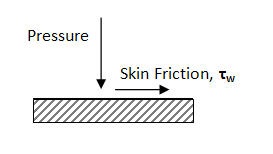...
| Info | ||||||||||||
|---|---|---|---|---|---|---|---|---|---|---|---|---|
| ||||||||||||
FLUENT report forces in term of pressure force and viscous force. For instance, we are interested in the drag on the airfoil, (Drag)total = (Drag)pressure + (Drag)viscous Drag due to pressure:
Drag due to viscous effect:
where ed is the unit vector parallel to the flow direction. n is unit vector perpendicular to the surface of airfoil. t is unit vector parallel to the surface of airfoil. Similarly, if we are interested in the lift on the airfoil, (Lift) = (Lift)pressure + (Lift)viscous Lift due to pressure:
Lift due to viscous effect:
where el is the unit vector perpendicular to the flow direction. n is unit vector perpendicular to the surface of airfoil. t is unit vector parallel to the surface of airfoil. |
...
 Sign-up for free online course on ANSYS simulations!
Sign-up for free online course on ANSYS simulations!